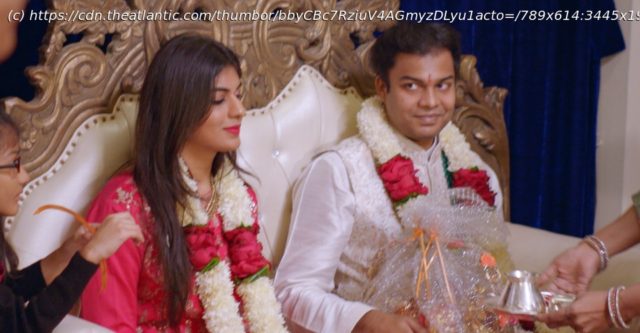The popular reality series is a tacit defense of arranged marriages and the role they play in upholding a system of discrimination.
This story contains some spoilers for Season 1 of Indian Matchmaking.
“Marriages are breaking like biscuits.”
The Mumbai-based matchmaker Sima Taparia delivers this meme-friendly one-liner in the seventh episode of the hit Netflix series Indian Matchmaking. Her sentiment seems antithetical to the title of the show, in which she travels tirelessly between Mumbai, Houston, San Diego, and Delhi to find the “perfect match” for her clients. Indian Matchmaking joins other recent reality dating series such as Love Is Blind and Too Hot to Handle—except the first dates are often in the company of one or both sets of the daters’ parents and the sex is nonexistent. In her questions about her clients’ preferences and her scrutiny of their lifestyles (and closets), Taparia is no different from any other matchmaker who promises relationships that can last forever. But she departs from this well-worn model in her attention to one extra characteristic: caste.
This silent shadow hangs over every luxurious living room she leads viewers into. “In India, we have to see the caste, we have to see the height, we have to see the age,” Taparia, the show’s central narrator and driving force, says in the first four minutes of the series. She lumps an entire social system, which assigns people to a fixed place in a hierarchy from birth, together with anodyne physical preferences. Though it’s rarely mentioned by name on the show, caste appears on almost every criteria list that Taparia’s marriage-hopefuls lay out. By coding caste in harmless phrases such as “similar backgrounds,” “shared communities,” and “respectable families,” the show does exactly what many upper-caste Indian families tend to do when discussing this fraught subject: It makes caste invisible.
The pervasiveness of caste in Indian communities, even beyond the ambit of arranged marriages, has dangerous consequences for those of us born into “lower” castes. (I myself am Dalit, the self-chosen identity for people formerly known as “untouchables.”)
This prejudiced treatment includes, but is hardly limited to, workplace discrimination in the United States. For example, the state of California sued the tech company Cisco in June for allegedly failing to protect a Dalit employee from discrimination by his higher-caste Brahmin managers. When a popular show like Indian Matchmaking neglects this alarming fact of the Indian American experience, it quietly normalizes caste for a global audience.
Contrary to what some viewers might think, the caste system is an active form of discrimination that persists in India and within the Indian American diaspora. One of the primary functions of arranged marriage is maintaining this status quo. This can be confirmed by a cursory glance at matrimonial columns in Indian newspapers, which are full of “Caste Wanted” headlines, or at the ubiquitous matchmaking websites that promise to help users find an upper-caste “Brahmin bride” or “Rajput boy,” while filtering profiles from people in lower castes. Marrying into the same caste of one’s birth is not, as Indian Matchmaking might suggest, a benign choice akin to finding someone who “matches your background” or has “similar values.” It’s a practice that helps dominant-caste folks preserve their power.
Caste, much like race, is an identity that you can’t change, erase, or escape.






